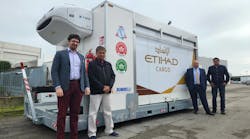The Need For Green GSE
The percentage of green GSE in any one handler’s fleet remains low if only for the simple reason that new equipment – green or not – comes with a big price tag. The industry’s default has always been to maintain existing GSE even if that equipment is decades old. And let’s face it: the stuff is built to last a long time.
However, rising fuel prices may make new electric models more attractive. Plus, changes in FAA VALE funding may provide an added boost. There is new language in the legislation that reauthorized the administration last year that may offer more dollars. Like all thousand-page laws, however, until rules are promulgated no one knows exactly what it will all mean, but the potential for better funding for predominately electric GSE exists.
Rising fuel prices is not just good news for electric GSE makers, but also for the GSE engine after-market. Our cover story in June/July discussed UPS Airlines’ ground operations with Bill Jacob. The vice president of GSE says regulations for gas-powered vehicles in California have produced enough savings to make swapping out old engines a winner at Worldport, its main hub in Kentucky, even when there are no regulations to force the issue.
The Need For Safety On The Ramp
The General Accountability Office concluded in a 2011 report that "efforts to address the occurrence of safety incidents in ramp areas were hindered by the lack of safety data on the nature, extent and cost of such incidents or accidents."
The GAO determined that neither the FAA nor the NTSB collected comprehensive data on incident or accident occurrences on the ramp.
The GAO's conclusion was that without this data the FAA could not assess the risk of catastrophic accidents on the ramp. While the FAA agreed with the GAO, it will be interesting to watch what the agency actually does in response to this report.
On a related note, a national report released earlier this year – and sponsored by the FAA – presents apron safety statistics and programs gathered during visits to U.S. and non-U.S. airports. The report is – at least in this country – one step toward developing a common set of data and consistent definitions.
Internationally, IATA announced that it will target ramp safety as one of its main priorities over the next 12 months to “harmonize” the work of the ICAO, FAA and EASA. In particular, the work focused on the ramp will be to enhance IATA’s IOSA program.
The Need For “Alternative” GSE Markets
By “alternative” we mean changes in how to purchase GSE. We are aware, for example, of a relative new-comer to financing GSE. The company has offices in the U.S. and the U.K. to service Europe. This particular business has purposely kept a low profile, but will be launching a new website and intends to talk with us more on this marketplace. The same company is also launching a rental program for GSE as well with the idea of filling short-term peak demands for a ground handler who does not want to make a large capital investment.
Internationally, a company we met last year at inter airport in Munich is targeting similar efforts in the Middle East. There are several companies in the Middle East supposedly representing various GSE manufacturers from around the globe. To the best of this company’s knowledge, however, none of them has a 100 percent focus on ground handling, and many have their fingers in plenty of non-aviation pies trading an array of engineering items and vehicles.
By alternative, we also mean the market for used equipment. Our inter airport contact also recently re-launched a website it says features more than 650 items located in 17 countries in Europe, North America, North Africa, the Middle East and Asia-Pacific, all for sale and/or rent, and supplied by ground handlers, GSE manufacturers and equipment traders.
Since an initial launch in 2010, the company says its website has received more than 300,000 hits and aims to reach half a million hits by the end of this year. By this summer, this site should also have additional functionality such as a section for buyers/renters to post requirements and provide a better match.
The used marketplace for GSE is, of course, nothing new. After asking one of our readers last year to send us the list of used GSE sites he said he looks at every Wednesday, he sent us a list of more than 20 all predominately in the U.S.
The Need For A Continuing International GSE Mindset
Not a week goes by that we don’t have about 10 new members to our LinkedIn Group – and nine of them are from outside the U.S.
Handlers are always being asked to square the circle, but many in Europe are facing what Americans have long battled – competition. Undoubtedly, a source of comoftable profits was due to the monopoly or near-monopoly many enjoyed thanks to EU regulations. The EU, however, intends to open competition up at most major European airports.
In terms of product development, as with most products that for one reason or another must be made more efficient and environmentally friendly, non-U.S. makers typically have an edge on this R&D since high energy costs and tougher environmental regulations are nothing new overseas.
Finally, new technologies in entirely different ways to save energy typically also have a European birth place. One such product that could either help or hinder ground support can be seen in increasing experiments by many different non-U.S. companies (although there is one U.S. company partnering with Lufthansa Technic) to develop self-taxiing equipment. Such systems typically use the aircraft’s APU to power motors installed in the wheels that allow the airplane to move in most any direction without the assistance of a pushback or tow.
This technology not only saves the airlines money spent on fuel, but also engine and brake maintenance and very expensive engine damage caused by FOD since the airplane’s engines only need to be powered up on the runway itself.
What else do you think we need?



